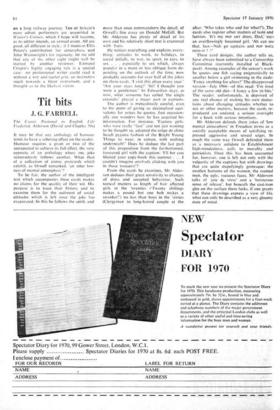Tit bits
J. G. FARRELL
The Comic Postcard in English Life Frederick Alderson (David and Charles 50s) It may be that any anthology of humour tends to have a sobering effect on the reader. Humour requires a grain or two of the unexpected to achieve its full effect, the very opposite of an anthology where one joke remorselessly follows another. What then of a collection of comic postcards which exhibit, as Orwell remarked, 'an utter low- ness of mental atmosphere'?
To be fair, the author of the intelligent text which accompanies these cards makes no claims for the quality of their wit. His purpose is to trace their history and to examine them for the sediment of social attitudes which is left once the joke has evaporated. In this he follows the spirit, and more than once commandeers the detail, of Orwell's fine essay on Donald McGill. But Mr Alderson has plenty of detail of his own and his relatively short text is crammed with facts. • He notices everything and explains every- thing: attitudes to work, to holidays, to social pitfalls, to war, to sport, to cars, to sex . . . especially to sex which, always popular in a more or less oblique form de- pending on the outlook of the time, now probably accounts for over half of the jokes on these cards. 'I visit this place every year.' `Are your stays long?"Sir! I thought you were a gentleman.' In Edwardian days, as now, what someone has called 'the single entendre' played a major part in captions.
The author is meticulously careful, even to the point of giving us decimalised equi- valents for prices he quotes. Just occasion- ally one wonders how he has acquired his information. For instance, 'Factory girls, who were really "fast" and not just wanting to be thought so, adopted the crepe de chine beach pyjama fashion of the Bright Young Things to wear, in cotton, with nothing underneath!' Does he deduce the last part of this proposition from the fat-bottomed,- trousered girl with the caption: bet you blotted your copy-book this summer . . . I couldn't imagine anybody clicking with you in those trousers!'?
From the cards he examines, Mr Alder- son deduces their great sensitivity to changes of dress and accepted behaviour. Such topical matters as length of hair affected girls in the 'twenties ('Twenty shillings makes a pound but one bob makes a swanked') no less than boys in the 'sixties (Clergyman to long-haired couple at the
• altar: 'Who takes who and for what?'),The cards also register other matters of taste and fashion. `It's my POP ART dress, Dad,' says an overflov,vingly bosomed girl. `Ah can see that, lass—Nah go upstairs and POP BACK INTO IT ! !'
These card designs, the author tells us, have always been submitted to a Censorship Committee (currently- installed at Black- pool). Among examples of the censor's work he quotes one fish saying enigmatically to another below a girl swimming in the nude: `Fancy anything for afters?' The disapproved version—July 1966—of this read: `I'm tired of the same old diet—I fancy a few tit-bits.'' The reader. unfortunately, is deprived of any real chance of making his own deduc- tions about changing attitudes whether to sex or other matters, because the cards re produced are undated, a serious oversight for a book with serious intentions.
Mr Alderson defends these jokes of `low mental atmosphere' in Freudian terms as a socially acceptable means of satisfying re- pressed aggressive and sexual urges. In much the same way Orwell defended them as a necessary antidote to Establishment high-mindedness, calls to morality and patriotism. Once this has been accounted for, however. one is left not only with the vulgarity of the captions but with drawings that are quite stupefyingly grotesque: the swollen bottoms of the women, the stunted men, the ugly, vacuous faces. Mr Alderson talks of 'joie de vivre' and a 'boisterous sense of release', but beneath the cast-iron glee on the surface there lurks, if one grants that these drawings express a view of life, what can only be described as a very gloomy state of mind.


































 Previous page
Previous page